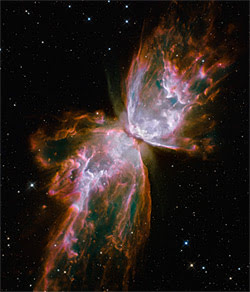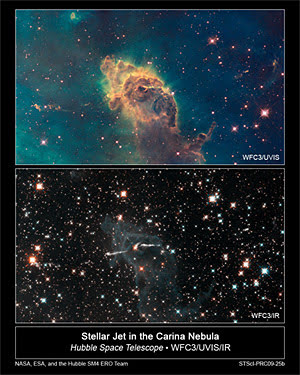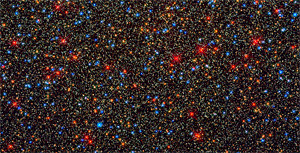
Rehabbed Hubble Opens Eyes
WASHINGTON, Sept. 9, 2009 – Colorful multiwavelength pictures of far-flung galaxies, an eerie “pillar of creation” and a butterfly-shaped nebula are some of the new observations taken by new and upgraded instruments on the renovated Hubble Space Telescope and released to the public today.

The Wide Field Camera 3 (WFC3), a new camera aboard NASA’s Hubble Space Telescope, snapped this image of the planetary nebula, catalogued as NGC 6302 but more popularly called the Bug Nebula or the Butterfly Nebula. What resemble dainty butterfly wings are actually roiling cauldrons of gas heated to more than 36,000 °F. The gas is tearing across space at more than 600,000 miles an hour – fast enough to travel from Earth to the moon in 24 minutes. A dying star that was once about five times the mass of the sun is at the center of this fury. It has ejected its envelope of gases and is now unleashing a stream of ultraviolet radiation that is making the cast-off material glow. (Images: NASA, ESA, and the Hubble SM4 ERO Team)
“This marks a new beginning for Hubble,” said Ed Weiler, associate administrator for NASA’s Science Mission Directorate at NASA headquarters. “The telescope has been given an extreme makeover and is now significantly more powerful than ever – well equipped to last far into the next decade.”
“On this mission we wanted to replenish the ‘toolkit’ of Hubble instruments that scientists around the world rely on to carry out their cutting-edge research,” said David Leckrone, senior Hubble project scientist at NASA’s Goddard Space Flight Center in Greenbelt, Md. “Prior to Servicing Mission 4 we had only three unique instrument channels still working, and today we have a total of 13.”
Hubble’s suite of new instruments is now allowing it to view a wide swath of the universe’s spectrum, from ultraviolet light all the way to near-infrared light. In addition, scientists released spectroscopic observations that slice across billions of light-years to probe the structure of the cosmic web that permeates the universe and also the distribution of the chemical elements throughout the universe that are fundamental to life as we know it.

These two images of a huge pillar of star birth 7500 light-years away in the Carina Nebula demonstrate the broad wavelength range of the new Wide Field Camera 3 (WFC3) aboard the Hubble Space Telescope, extending from ultraviolet to visible to infrared light. The top image, taken in visible light, shows the tip of the 3-light-year-long pillar, bathed in the glow of light from hot, massive stars off the top of the image. Scorching radiation and fast winds (streams of charged particles) from these stars are sculpting the pillar and causing new stars to form within it. Streamers of gas and dust can be seen flowing off the top of the structure. Nestled inside this dense structure, hidden by a wall of gas and dust, are fledgling stars. In the bottom image, taken in near-infrared light, the dense column and the surrounding greenish-colored gas all but disappear; only a faint outline of the pillar remains. By penetrating the wall of gas and dust, the infrared vision of WFC3 reveals the infant star. The WFC3 observed the Carina Nebula July 24-30, 2009.
The new instruments are more sensitive to light and will significantly improve Hubble’s observing efficiency. The space telescope is now able to complete observations in a fraction of the time that was needed with earlier generations of Hubble instruments.

“We couldn’t be more thrilled with the quality of the images from the new Wide Field Camera 3 (WFC3) and the repaired Advanced Camera for Surveys (ACS), and the spectra from the Cosmic Origins Spectrograph (COS) and the Space Telescope Imaging Spectrograph (STIS). The targets we’ve selected to showcase Hubble’s capabilities reveal the great range of abilities in our newly upgraded Hubble,” said Keith Noll, leader of the team at the Space Telescope Science Institute (STScI) in Baltimore that planned the early release observations.
These results are compelling evidence of the success of the STS-125 servicing mission in May, officials said, which has brought the premier space observatory to the peak of its scientific capabilities. Two new instruments, the WFC3 and COS, were installed, and two others repaired at the circuit board level: the ACS and STIS. Mission scientists also announced today that the Near Infrared Camera and Multi-Object Spectrometer (NICMOS) were brought back into operation during the three months of calibration and testing.
For the past three months scientists and engineers at STScI and the Goddard Space Flight Center have been focusing, testing and calibrating the instruments. Hubble is one of the most complex space telescopes ever launched, and the Hubble Servicing Mission astronauts performed major surgery on the 19-year-old observatory’s multiple systems. This orbital verification phase was interrupted briefly July 19 to observe Jupiter in the aftermath of a collision with a suspected comet.

NASA’s Hubble Space Telescope snapped this panoramic view of a colorful assortment of 100,000 stars residing in the crowded core of a giant star cluster. The image reveals a small region inside the massive globular cluster Omega Centauri, which boasts nearly 10 million stars. Globular clusters, ancient swarms of stars united by gravity, are the homesteaders of our Milky Way galaxy. The stars in Omega Centauri are between 10 billion and 12 billion years old. The cluster lies about 16,000 light-years from Earth. This is one of the first images taken by the new Wide Field Camera 3 (WFC3), installed aboard Hubble in May 2009, during Servicing Mission 4. The camera can snap sharp images over a broad range of wavelengths.
Hubble now enters a phase of full science observations. The demand for observing time will be intense. Astronomers look forward to using the telescope to conduct a broad range of observations: from studying the population of Kuiper Belt objects at the fringe of our solar system, to observing the birth of planets around other stars, to probing the composition and structure of extrasolar planetary atmospheres.
There are ambitious plans to take the deepest-ever near-infrared portrait of the universe to reveal never-before- seen infant galaxies that existed when the universe was less than 500 million years old. Other planned observations will attempt to shed light on the behavior of dark energy, a repulsive force that is pushing the universe apart at an ever-faster rate.
The Hubble Space Telescope, launched in 1990, is a project of international cooperation between the European Space Agency and NASA; as a result of this agreement European astronomers have guaranteed access to 15 percent of Hubble’s observing time.
For more information, visit: http://hubblesite.org
Published: September 2009